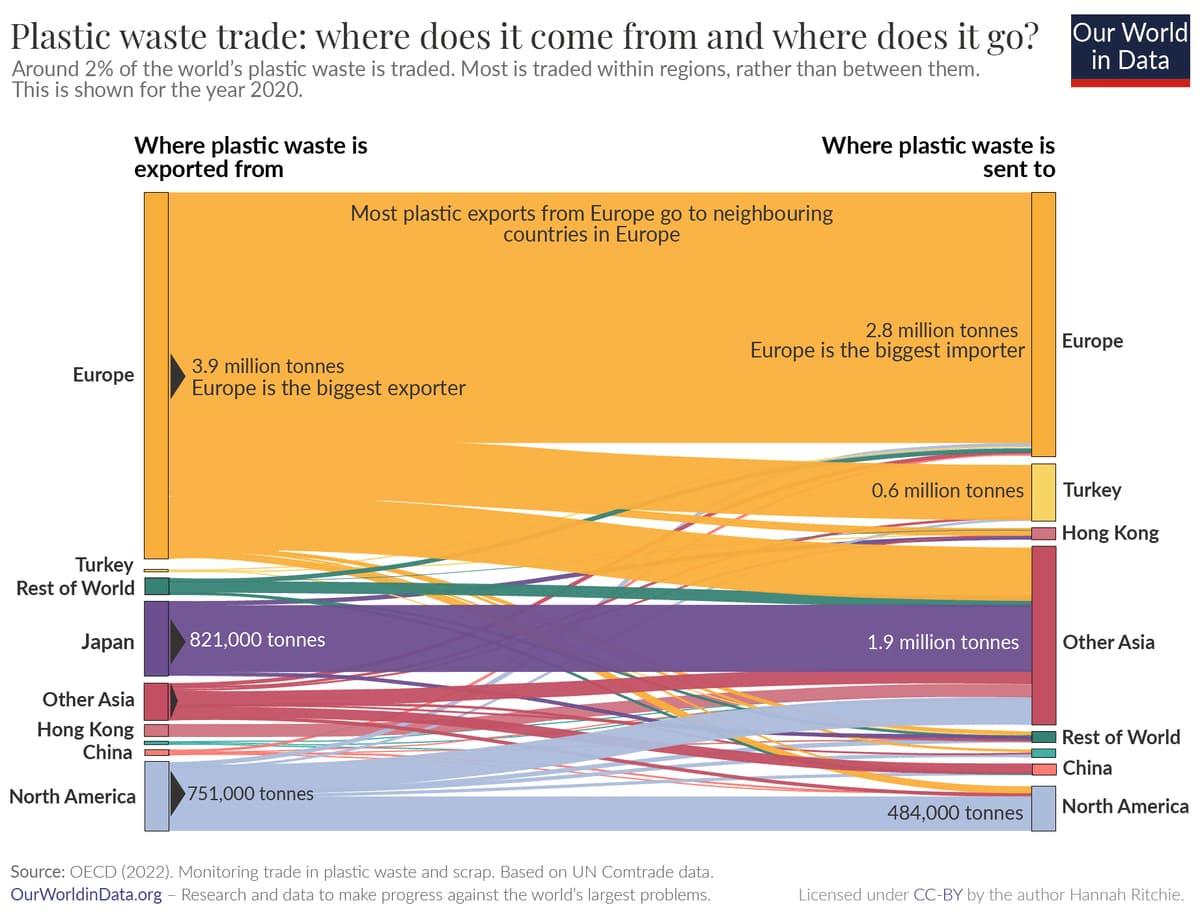
The Global Plastic Waste Trade

Charting the Movement of Global Plastic Waste
Every year, nations worldwide produce around 350 million metric tons of plastic waste. This is equivalent to over 10 million fully loaded garbage trucks.
Most of this plastic waste is either incinerated or sent to landfills, thus eventually polluting our air, land, and oceans. Only a fraction of this waste is recycled, and contrary to popular belief, just 2% is traded internationally.
This graphic by Our World in Data uses data from OECD and UN Comtrade to reveal just how much plastic waste is traded across borders, and which countries are estimated to export and import the most of it.
Why Trade Waste?
Though most plastic waste is managed and recycled within countries, exporting spare waste helps manage a part of their plastic emissions more cheaply and reduces pressure on local recycling facilities and landfills.
Importing plastics, on the other hand, comes with certain financial benefits too. Repurposing recycled plastics into goods is a far cheaper option for industries that would otherwise rely on buying newly manufactured expensive plastics. And many countries differ when it comes to their specific plastic recycling capabilities and needs, so while they might export some plastic waste, they also import others that are useful.
Research has even found that higher plastic waste imports have positively impacted the economic growth of many low-income countries, in the right circumstances.
However, when countries export unusable and non-recyclable contaminated plastics, these same low-income nations may see the end-of-life ecosystem costs outweigh any financial benefits.
The World’s Biggest Plastic Importers and Exporters
With its reported plastic waste exports nearing four million metric tons, Europe exports nearly 80% of the world’s traded plastic waste. However, as most is reportedly exported to other European nations, it is also the largest importing region.
Here are the world’s top 10 plastic waste exporters in 2020 according to UN Comtrade data:
| Rank | Country | Exported Plastic Waste (2020) |
| 1 | Germany | 853,860,858 kg |
| 2 | Japan | 820,742,495 kg |
| 3 | USA | 624,511,072 kg |
| 4 | United Kingdom | 560,986,540 kg |
| 5 | Netherlands | 413,233,255 kg |
| 6 | Belgium | 346,218,522 kg |
| 7 | France | 333,748,686 kg |
| 8 | Italy | 217,167,070 kg |
| 9 | Slovenia | 181,914,979 kg |
| 10 | Austria | 179,322,638 kg |
Due to political reasons, UN Comtrade includes Taiwan data under “Other Asia, not elsewhere specified.”
Germany, which is the world’s largest exporter of plastic scraps and waste at 854 million kilograms, relies primarily on the Netherlands, Poland, Austria, Switzerland, Türkiye, and Malaysia to manage this plastic waste.
Asia’s largest plastic exports are from Japan, which trades primarily with other Asian countries including Malaysia, Vietnam, Thailand, and Korea. In 2020, Japan was the world’s second-largest plastic waste exporter with 821 million kilograms shipped.
Third on this list is the United States. The country is estimated to have exported more than 600 million kilograms of plastic waste in 2020, and while a majority was traded with Canada, a portion also went to Mexico, Malaysia, Vietnam, India, Hong Kong, and Indonesia.
And on the receiving end, Malaysia and Türkiye have become the world’s largest plastic waste importers, primarily from within their respective regions:
| Rank | Country | Imported Plastic Waste (2020) |
| 1 | Malaysia | 715,274,628 kg |
| 2 | Türkiye | 619,287,422 kg |
| 3 | Germany | 567,239,848 kg |
| 4 | Viet Nam | 440,706,678 kg |
| 5 | Netherlands | 417,312,448 kg |
| 6 | USA | 243,981,665 kg |
| 7 | Indonesia | 233,926,526 kg |
| 8 | Other Asia, nes | 230,934,455 kg |
| 9 | Poland | 195,332,771 kg |
| 10 | Italy | 192,114,936 kg |
How the Plastic Waste Trade is Changing
Up until 2017, China was one of the world’s largest plastic waste importers, which it used for its manufacturing industries. In 2018, it imposed import bans on 24 types of recyclable waste, and their plastic waste imports dropped by over 95% within a year.
In 2019, 187 nations signed an international treaty called the Basel Convention on the Control of Transboundary Movements of Hazardous Wastes and their Disposal. Aimed at addressing the gaps in plastic waste disposal, this treaty restricts participating nations from trading plastic scraps internationally, unless it lacks sufficient recycling or disposal capacity.
And over the last decade, the global plastic trade has indeed declined tremendously. But millions of tons of plastic are still being shipped (and mismanaged).
More News
Sustainability in Supply Chain Management: A Comprehensive Guide
This comprehensive guide explores how sustainability is transforming supply chai...
EU Simplifies Carbon Border Adjustment Mechanism (CBAM)
The European Union has approved new rules to simplify the Carbon Border Adjustme...
Understanding Sustainability Roadmap: Aligning Purpose, Performance and Profitability
A sustainability roadmap enables organisations to align purpose, performance, an...
The Untapped Risk of Water Management in Sustainability
Water risk is rapidly becoming a material financial issue, with growing exposure...
Cement and Concrete in Net Zero
A global shift is underway in the path to net zero — from pledge-based allianc...


